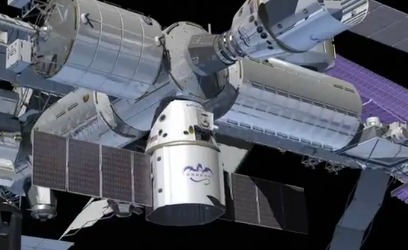
SpaceX Dragon spacecraft shown in a hypothetial dock with the ISS. The next test of this system is scheduled for 30 April
That was my opening line at a small talk over the weekend, my warmer upper, it’s not exactly a spine tingler, but it’s the truth. The only manned ground to orbit launch capacity on earth exist in Rsocosmos, the dregs of the Russian manned program. Because of management missteps, congressional malfeasance, a world-wide recession and austerity programs in the few space faring countries left standing, we as a species, ladies and gentlemen, are about one single launch/operational/reentry disaster away from having no manned capability at all, while a luxury free-fall hotel and science station weighing in at almost a million pounds whizzes around empty of science and man until it burns into a briefly spectacular, $100 billion high-altitude fireworks show. Right now much of our hope hinges on this event:
(Forbes) — The much-anticipated launch of SpaceX’s Dragon capsule to the International Space Station has seen some delays due to the need for additional testing, but now things are looking good. I confirmed with NASA and SpaceX this morning that the Space Agency has set a target date of April 30th for the Dragon’s historic launch to the International Space Station, where it will rendezvous and dock.
The Russians were good engineers, they built robust boosters and rugged capsules, over the subsequent decades the features have been refined. It’s ironic; they lost the cold war and yet that 50 year-old design is all that stand between us and an earthbound existence. But even those designs have tolerances critically dependent on cost and cost cutting. And our rooski pals have pretty much pushed it all to the limit. The Russian space agency is stumbling, racking up delays and cost over runs, mismatched components, accidents, and more recently the head of Roscomos getting the shit beat out of him for hiring a 20 something year-old bimbo and former model-escort as head of his media relations.
As bad as that is, the Russian have done OK considering what they had to work with. As cold war winners and last one standing, we went on to blow our winnings in less than a decade on tax cuts for billionaires, a costly war in Iraq, and sweetheart deals for multinational corporations that ship our middle class overseas one job at a time. NASA was lucky to survive at all, given those priorities. But our manned program was running on — and running out — of the old Apollo era glory that sustained it. Now, with the space shuttle retired, and no coordinated long-term post shuttle plan ever getting off the ground, literally, for the last 30 years, there will be no traditional aerospace manned rocket doing what the Russians can do right now coming from NASA for at least 10 years. If we’re willing to double the budget and triple the flight testing risk, we might possibly get one in five, but most US space watchers think it more likely we’ll triple the budgetary pork, double the development time, and never even see a full-sized hard mock-up get to the VAB, let the real McCoy on a pad.
There are several companies that have vehicles that can put man and cargo into LEO in late stage testing. SpaceX leads the pack, but there are others nipping at their heels. With funding and an accelerated test schedule, SpaceX could probably have an operational Falcon 9 booster rated for cargo next year and a man rated Dragon spacecraft and booster combo ready for operational testing in two years or less. If both those phases went well the company could start rolling these rockets and craft out of their facilities as fast as governments and commercial firms could afford to buy them.
Within five years the Hawthorne based new space firm could probably put a Falcon Heavy on the pad. A rocket so powerful it could service an orbiting fuel depot and jump-start heavy deep space exploration, or put up a full-blown command module and lunar lander in one shot with enough fuel for a trip to the moon or a near earth object. The reusable liquid fuel booster/capsule seems to be the best bet for a short-term, viable solution, that can bring cost way down and bring the number of launches way up, higher than its ever been, anywhere form a dozen to a potentially a hundred launches a year.
That’s why the test to the ISS on 30 April is so important. If you want to know more, SpaceX’s cofounder, Elon Musk, will on the Daily Show with Jon Stewart Tuesday night talking about the mission and the future of US space exploration.

But . . . but . . . but President Gingrich will get us a permanent moon base within eight years.
In all seriousness, this is very distressing and was completely preventable. I’ve watched over the past 20 years as one proposed replacement vehicle for the shuttle after another was scrapped by politicians from both parties. We knew the shuttle would eventually have to be retired, yet we wasted billions trying to keep reinventing the wheel.
I was born in the same month that Neil Armstrong made the first human footprints on another body in the solar system. Everything else has made huge leaps forward since then. I now carry around in my pocket a phone that has more computing power than the entire Apollo program had. The fact that our capabilities for sending humans into space is less than it was on the day I was born is disgracefull.